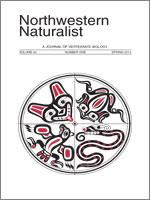Glaucous-winged Gulls (Larus glaucescens) and Western Gulls (Larus occidentalis) are found along the Pacific Coast of North America. Where their breeding ranges overlap in Oregon and Washington they hybridize, producing a continuum of phenotypic variation. Whereas most colonies containing these hybrids are found on islands along the coast, several, including a large colony at Protection Island National Wildlife Refuge, WA, USA, are located in the Salish Sea. In 2010, we scored the phenotypes of 81 gull pairs at the Protection Island colony using an index based on plumage melanism and bare-part coloration. We also monitored the breeding success of these pairs. Gulls from the entire range of phenotypes in the L. glaucescens-occidentalis complex bred on the colony, although most gulls appeared more like L. glaucescens. Significant assortative mating based on colorimetric phenotype occurred on the colony, but a low number of L. occidentalis-type pairs appeared primarily responsible for this trend. Although the mass of the 3rd egg in the clutch was significantly smaller for pairs with increasingly L. occidentalis-like males, we observed no significant difference in hatching success or clutch size across the range of phenotypes.
How to translate text using browser tools
4 April 2013
Mating Patterns and Breeding Success In Gulls of the Larus glaucescens-occidentalis Complex, Protection Island, Washington, USA
Andre E Moncrieff,
Libby C Megna,
James L Hayward
ACCESS THE FULL ARTICLE

Northwestern Naturalist
Vol. 94 • No. 1
Spring 2013
Vol. 94 • No. 1
Spring 2013
assortative mating
breeding success
egg size
Glaucous-winged Gull
hybridization
Larus glaucescens
Larus occidentalis




